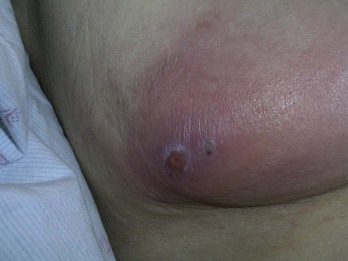17 Incision and Drainage
Incision and drainage (I&D) is a simple in-office procedure that in most cases is curative for superficial abscesses and related infections including uncomplicated methicillin-resistant Staphylococcus aureus (MRSA) abscesses. Commonly, patients will present with the acute onset of localized pain, swelling, and erythema indicating abscess formation (Figure 17-1). These can be the result of trauma, injection drug use, insect stings or bites, a secondary infection or inflammation of an epidermoid cyst, or paronychia from nail biting or manipulation, or they may arise without a clear inciting event.
The most common pathogens are Staphylococcus aureus and Streptococcus bacteria. Systemic antibiotics should usually only be given if there is surrounding cellulitis (Figure 17-2) or other signs or symptoms of further infection. There is no clear need for antibiotics even if localized MRSA is present, and there is also no clear indication for antibiotics in a patient with diabetes or an immune-compromised patient as long as the infection is a localized one that can be drained.1,2 Some patients may be colonized with MRSA and develop recurrent abscesses. In this situation, treatment with systemic antibiotics such as trimethoprim/sulfamethoxazole, doxycycline, or clindamycin based on local sensitivity patterns may help. Mupirocin is applied inside the nares twice daily for 5 days and topical chlorhexidine skin washing is commonly used to try to clear the carrier state, although the literature does not clearly support these practices.3,4
Contraindications and Cautions
Advantages of Incision and Drainage
Advantages for the patient include:











